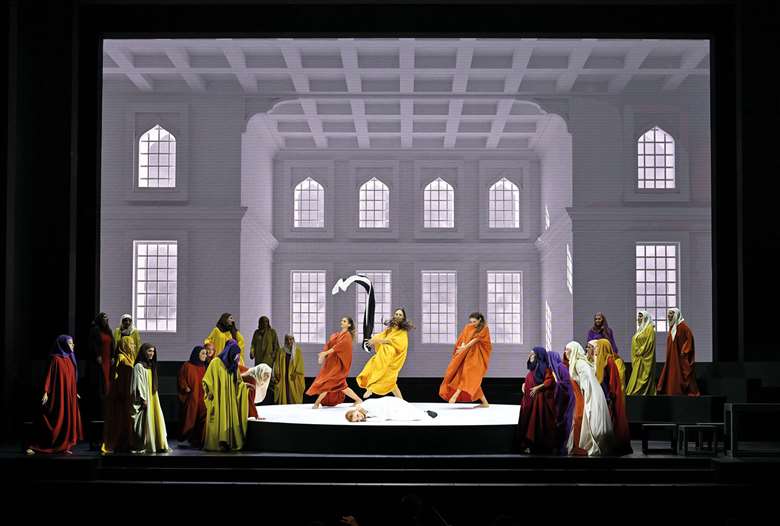Festival Verdi 2023 – Verdi: Il trovatore & I Lombardi | Live Review
Thursday, April 4, 2024
The unqualified success of I Lombardi alla Prima Crociata which inaugurated 2023’s Festival Verdi bodes well for the festival’s future

Gala Verdiana ★★★☆☆
Arriving in Parma on Verdi’s birthday, 10 October, was the spectacular ‘Gala Verdiana’, commemorating the maestro’s 210th birthday. The celebration had been elevated from previous less-remarkable recitals of a few singers to a major gala with a large orchestra, sharing the stage with a full chorus, and parade of singers. Luciano Messi, superintendent of the Teatro Regio, wanted to restore the ‘gala’ aspect of the evening. Huge photos of Verdi, showing his Sant’Agata home, inside and out, including the piano where he composed many operas, were projected during the event. This gala was also a fundraiser to save Sant’Agata from the auction block. The concert itself was emotional, with big voices at full-throttle, but lacked shading and finesse, with a couple of artists slightly off-pitch. Although Omer Meir Wellber conducted with energy and drama, he failed to elicit the depth and breadth inherent in Verdi’s music. Nevertheless, the audience responded enthusiastically, especially to mezzo soprano Clementine Margaine, who perfectly pitched both singing and dramatic intensity, and the only singer called back for a second round of applause.
Il trovatore ★★★★☆
Director David Livermore transposed Trovatore from 15th-century (or 19th-century as the programme synopsis stated) northern Spain into a dystopian society in an apocalyptic world. In his Regietheater concept, Trovatore became a Class War Between the haves and the have nots. Nevertheless, he kept a touch of tradition with déjà vu stage direction. The opera unfolded amid the modern steel and glass high-rise buildings of the wealthy, entitled ruling class. A fire in the distance indicated where society’s masses of the outcasts, poor and desperate live, huddled beneath a concrete overpass strewn with garbage, burned out cars and tyres, brought into focus in subsequent scenes.
All was vibrantly brought to life between a combination of changing stage configurations and the LED wall unleashing mesmerising exploding images of volcanic eruptions, spreading fires, water polluted with blood and fire, a storm cloud-filled sky, and a peaceful starry night. When ‘sangue’ was sung, the scene turned blood red and evoked poison slowly spreading through veins. The gypsy camp was transformed into a circus of misfits, clowns, fire eaters and jugglers. The cloister became an abandoned hospital where the circus outcasts hid under bedsheets and ultimately changed the opera’s ending, (spoiler alert) killing the Count’s guards after Manrico was murdered.
There were mixed results among the four leads. Clementine Margaine assayed Azucena with a full-bodied vocal instrument, dramatic expressiveness and strong stage presence. Francesca Dotto as Leonora had an impressive voice, light and agile (bel canto-like) but insufficient depth and character for a Verdi soprano. Riccardo Massi sang Manrico with a tinge of emotion revealing inner turmoil in a dramatically forceful performance. Giovanni Meoni was the weak link in the quartet as Count di Luna, with a small voice. Francesco Ciampa kept good pacing and tension. I would have preferred, however, if he had extracted more distillation of the notes from the orchestra to reveal the essence of Verdi’s opera.
I Lombardi ★★★★★
The unqualified success of I Lombardi alla Prima Crociata which inaugurated 2023’s Festival Verdi bodes well for the festival’s future. It was the finest, most exquisite production I have seen at the Festival in more than a decade of attending. Pier Luigi Pizzi, the 93-year-old director, who also designed the sets, costumes, and video, unequivocally proved that age is an irrelevant number. He created a traditional production of pure and unpretentious beauty, with a touch of modernity including colours and contrasts assisted by an immense LED wall.
The scenography was black and white – splashes of colour – blue, orange, purple, yellow were reserved for costumes, and red for fires. The contrast between black and white, the presence and absence of light, life, good and evil embodied the opera’s themes of conflict, religious extremism and war. His masterful directing succeeded in sewing together and giving meaning to the fragmentary and discontinuous storyline for which Verdi composed the music.
By streamlining the convoluted plot, Pizzi strengthened Verdi’s message: ‘War is always unjust’. Without the need to update, surprise, or shock, he did full justice to Verdi’s opera with impeccable taste and masterful art.
On the LED wall, images were vividly projected, opening and closing the opera with a white canvas background sliced with a vertical black brush stroke. In between were projections of the various scene locations: atrium of Sant’Ambrogio, the Folco palace, Acciano’s palace, a cave in the desert, Acciano’s harem, Valley of Jehoshaphat, and Jerusalem in the distance. The projected monumental architecture created a cold, dreamlike atmosphere. A large circular platform was placed centre stage, around which the action unfolded, adding symbolic expressiveness while delving into the characters.
The singing was exemplary. Lidia Fridman made her debut as Giseldawith an impactful performance that was technically solid, while demonstrating a strikingly powerful and agile vocal instrument. She mastered the role with energy and confidence. Michele Pertusi was ideally suited as Pagano with his fluid, accomplished singing, captivating timbre and well-delineated characterisation. Antonio Corianò made an incisive Arvino, assaying the role with balanced vocal texture and an impressive interpretation. William Corrò was an effective and intense Acciano and Antonio Poli as Oronte excelled with a soft, luminous, bel canto voice and outstanding phrasing. The chorus played a leading role in the opera. Well-trained by Martino Faggiani, the choral ensemble was outstanding with its display of vocal colour, especially with ‘O Signore, dal roof natìo’ (Oh Lord from the native roof). Maestro Francesco Lanzillotta led with precision and confidence, keeping cohesion and unity throughout.
This article originally appeared in the Summer 2024 issue of Opera Now. Never miss an issue – subscribe today






